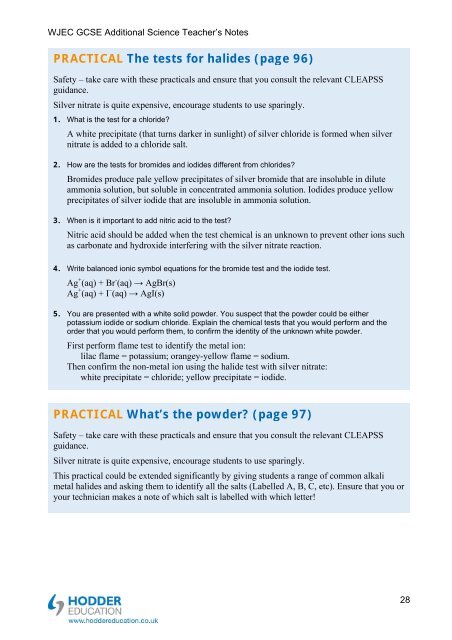Teacher's notes and answers to questions in the book - Hodder Plus ...
Teacher's notes and answers to questions in the book - Hodder Plus ...
Teacher's notes and answers to questions in the book - Hodder Plus ...
Create successful ePaper yourself
Turn your PDF publications into a flip-book with our unique Google optimized e-Paper software.
WJEC GCSE Additional Science Teacher’s Notes<br />
PRACTICAL The tests for halides (page 96)<br />
Safety – take care with <strong>the</strong>se practicals <strong>and</strong> ensure that you consult <strong>the</strong> relevant CLEAPSS<br />
guidance.<br />
Silver nitrate is quite expensive, encourage students <strong>to</strong> use spar<strong>in</strong>gly.<br />
1. What is <strong>the</strong> test for a chloride<br />
A white precipitate (that turns darker <strong>in</strong> sunlight) of silver chloride is formed when silver<br />
nitrate is added <strong>to</strong> a chloride salt.<br />
2. How are <strong>the</strong> tests for bromides <strong>and</strong> iodides different from chlorides<br />
Bromides produce pale yellow precipitates of silver bromide that are <strong>in</strong>soluble <strong>in</strong> dilute<br />
ammonia solution, but soluble <strong>in</strong> concentrated ammonia solution. Iodides produce yellow<br />
precipitates of silver iodide that are <strong>in</strong>soluble <strong>in</strong> ammonia solution.<br />
3. When is it important <strong>to</strong> add nitric acid <strong>to</strong> <strong>the</strong> test<br />
Nitric acid should be added when <strong>the</strong> test chemical is an unknown <strong>to</strong> prevent o<strong>the</strong>r ions such<br />
as carbonate <strong>and</strong> hydroxide <strong>in</strong>terfer<strong>in</strong>g with <strong>the</strong> silver nitrate reaction.<br />
4. Write balanced ionic symbol equations for <strong>the</strong> bromide test <strong>and</strong> <strong>the</strong> iodide test.<br />
Ag + (aq) + Br - (aq) → AgBr(s)<br />
Ag + (aq) + I – (aq) → AgI(s)<br />
5. You are presented with a white solid powder. You suspect that <strong>the</strong> powder could be ei<strong>the</strong>r<br />
potassium iodide or sodium chloride. Expla<strong>in</strong> <strong>the</strong> chemical tests that you would perform <strong>and</strong> <strong>the</strong><br />
order that you would perform <strong>the</strong>m, <strong>to</strong> confirm <strong>the</strong> identity of <strong>the</strong> unknown white powder.<br />
First perform flame test <strong>to</strong> identify <strong>the</strong> metal ion:<br />
lilac flame = potassium; orangey-yellow flame = sodium.<br />
Then confirm <strong>the</strong> non-metal ion us<strong>in</strong>g <strong>the</strong> halide test with silver nitrate:<br />
white precipitate = chloride; yellow precipitate = iodide.<br />
PRACTICAL What’s <strong>the</strong> powder (page 97)<br />
Safety – take care with <strong>the</strong>se practicals <strong>and</strong> ensure that you consult <strong>the</strong> relevant CLEAPSS<br />
guidance.<br />
Silver nitrate is quite expensive, encourage students <strong>to</strong> use spar<strong>in</strong>gly.<br />
This practical could be extended significantly by giv<strong>in</strong>g students a range of common alkali<br />
metal halides <strong>and</strong> ask<strong>in</strong>g <strong>the</strong>m <strong>to</strong> identify all <strong>the</strong> salts (Labelled A, B, C, etc). Ensure that you or<br />
your technician makes a note of which salt is labelled with which letter!<br />
28

















